|
|

|
|
Author
|
Topic: NASA Artemis lunar terrain vehicles (LTV)
|
Robert Pearlman
Editor Posts: 54868
From: Houston, TX
Registered: Nov 1999
|
 posted 02-06-2020 08:56 AM
posted 02-06-2020 08:56 AM
   
NASA release NASA to Industry: Send Ideas for Lunar RoversAs NASA's Artemis lunar exploration program mounts toward a robust decade of modern science, research, and human exploration at the Moon, the agency is asking American companies to think about how to get around on the lunar surface. 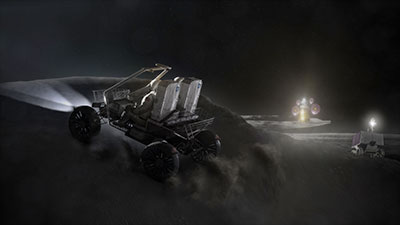 NASA issued two separate Requests for Information (RFI) seeking industry approaches for development of robotic mobility systems and human-class lunar rovers. With these RFIs, NASA seeks to foster an emerging American market of lunar transportation capability by engaging the terrestrial vehicle and robotic communities. First, the space agency is asking for concepts on robotic mobility systems to transport instruments across the lunar surface, conducting critical scientific research across wide areas of terrain, including areas where humans may not explore. "As we return to the Moon with Artemis, we're seeking new and innovative approaches that allow us to operate robotically anywhere on the lunar surface and explore more of our nearest neighbor than ever before," said Steve Clarke, deputy associate administrator for exploration, Science Mission Directorate at NASA Headquarters in Washington. "We are turning to industry to offer us exciting approaches to leverage existing systems here on Earth—including law enforcement, military, or recreational vehicles—that could be modified for use in space to enhance our mobility architecture." To expand the exploration footprints of the first woman and next man on the Moon, NASA also is seeking industry feedback on relevant state-of-the-art commercial technologies and acquisition strategies for a new lunar terrain vehicle or LTV. The LTV will be a human-rated, unpressurized (unenclosed) rover that will be used to help astronauts explore and conduct experiments somewhere humans have never been before: the lunar South Pole. "The most we can expect crew to walk while wearing their spacesuits is about a half-mile," said Marshall Smith, director of human lunar exploration programs in the Human Exploration and Operations Mission Directorate at NASA Headquarters. "If we can place a rover near a landing site before crew arrive, the potential for scientific return on those first missions will grow exponentially." The proof is in the past. The total areas explored for Apollo astronauts grew from a little over half a mile during Apollo 11, to 15 miles during Apollos 15-17. With the Lunar Roving Vehicle, astronauts were able to explore much more diverse geological features to maximize the science return of those missions. 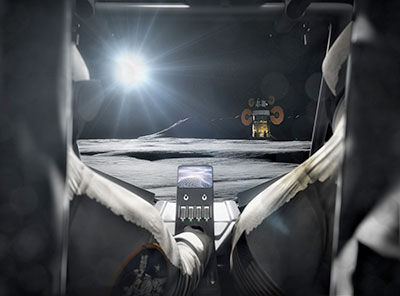 "We also want to hear from industry leaders in all-terrain vehicles, electric vehicles, and more—this is not exclusive to the space industry," notes Smith. "We want our rovers on the Moon to draw on, and spur, innovations in electric vehicle energy storage and management, autonomous driving, and extreme environment resistance." Clarke added, "Companies of all sizes are already partnering with us to deliver payloads to the lunar surface through our Commercial Lunar Payload Services (CLPS) initiative. We look forward to what industry shares with us as we consider early ideas on how humanity will explore the Moon robotically and with crew in the coming years." Increasing mobility on the Moon is the latest step to strengthen NASA's Artemis program, where the agency will use the Moon to test new systems and technologies before sending crew to Mars in the 2030s. The agency will soon select new providers to design and develop a Human Landing System as well as new logistics suppliers for the Gateway in lunar orbit. And, as Clarke mentioned, NASA is continuing to accelerate its scientific work ahead of a human return, working with a pool of 14 companies on contract to bid on commercial Moon deliveries. Two of those providers, Astrobotic and Intuitive Machines, will deliver the first sets of science instruments and technology development payloads to the lunar surface next year. The RFIs are to inform strategic planning, inviting industry to provide information to help shape the evolution of the Artemis mobility architecture to achieve the greatest scientific and exploration value. |
Robert Pearlman
Editor Posts: 54868
From: Houston, TX
Registered: Nov 1999
|
 posted 11-02-2022 11:15 AM
posted 11-02-2022 11:15 AM
   
NASA release NASA Makes Progress with New Lunar Terrain Vehicle Moon Rover ServicesAs astronauts explore the South Pole region of the Moon during Artemis missions, they will be able to go farther and conduct more science than ever before thanks to a new Lunar Terrain Vehicle (LTV). Instead of owning the vehicle, NASA plans to contract it as a service from industry. 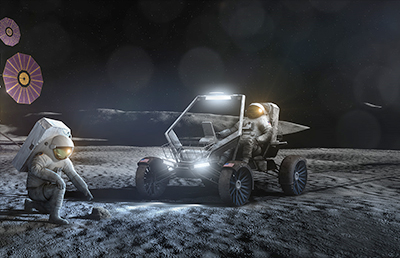 The draft request for proposals for the LTV Services (LTVS) contract is now ready for industry to review, and NASA will accept feedback until Dec. 1. The draft outlines NASA's expectation for use of the LTV on the lunar surface in the 2028 timeframe. After taking industry feedback into account, NASA plans to issue a final request for proposals by early 2023. "This draft is one of the first important steps in this exciting project that will allow astronauts to explore farther on the Moon than ever before," says Lara Kearney, manager of the Extravehicular Activity (EVA) and Human Surface Mobility (HSM) Program at NASA's Johnson Space Center in Houston. "Gaining industry feedback is crucial as we move forward in issuing a final request for proposal." This iconic style of unpressurized, human-class rover which debuted during the Apollo missions is a cornerstone in NASA's plans to develop a long-term presence on the lunar surface. While those human-driven vehicles expanded lunar exploration capabilities significantly, the new Artemis LTV will feature multiple upgrades and advanced technology. Because Artemis missions will be targeting the lunar South Pole area, the new LTV must be able to withstand and operate in cold and unique lighting conditions. The Artemis LTV is also expected to be able to cover a range of hundreds of miles per year, enabling access to diverse locations that will facilitate science discoveries, resource prospecting, and exploration. It will also be capable of remote operation and will be available for other commercial uses when not carrying out NASA research and operations. Contracting services from industry partners allows NASA to leverage commercial innovation and provide the best value to U.S. taxpayers while achieving its human spaceflight and exploration goals. The contract will support continued science and long-term human exploration at the Moon under Artemis, which will land the first woman and first person of color on the lunar surface. |
Robert Pearlman
Editor Posts: 54868
From: Houston, TX
Registered: Nov 1999
|
 posted 05-26-2023 01:25 PM
posted 05-26-2023 01:25 PM
   
NASA release NASA Pursues Lunar Terrain Vehicle Services for Artemis MissionsNASA is seeking industry proposals for a next-generation LTV (Lunar Terrain Vehicle) that will allow astronauts to go farther and conduct more science than ever before as they explore the south polar region of the Moon during Artemis missions. Artemis astronauts will drive to explore and sample more of the lunar surface using the LTV than they could on foot. NASA will contract LTV as a service from industry rather than owning the rover. Contracting services from industry partners allows NASA to leverage commercial innovation and provide the best value to U.S. taxpayers while achieving its human spaceflight scientific and exploration goals. "We want to leverage industry's knowledge and innovation, combined with NASA's history of successfully operating rovers, to make the best possible surface rover for our astronaut crews and scientific researchers," said Lara Kearney, manager of NASA's Extravehicular Activity and Human Surface Mobility program at the agency's Johnson Space Center in Houston. The LTV will function like a cross between an Apollo-style lunar rover and a Mars-style uncrewed rover. It will support phases driven by astronauts and phases as an uncrewed mobile science exploration platform, similar to NASA's Curiosity and Perseverance Mars rovers. This will enable continued performance of science even when crews are not present on the lunar surface. Artemis astronauts will use the LTV to traverse the lunar surface and transport scientific equipment, extending the distances they can cover on each moonwalk. Under the Lunar Terrain Vehicle Services request for proposals, NASA has provided requirements for companies interested in developing and demonstrating the LTV, including an approach that encourages companies to produce an innovative rover for use by NASA and other commer cial customers for multiple years. Engineers will be able to operate the LTV remotely to transport cargo and scientific payloads between crewed landing sites, enabling additional science returns, resource prospecting, and lunar exploration. This will expand scientific research opportunities on the Moon during uncrewed operations, allow scientists to investigate future surface mission locations, and inform research goals and objectives for each site. To handle the unique environment near the lunar South Pole, which includes permanently shadowed regions and extended periods without sunlight, the LTV will need to incorporate several systems to support both crewed and uncrewed operations. Some of the more critical systems include advanced power management, semi-autonomous driving, state-of-the-art communication and navigation systems, and protection from the extreme environment. As part of the proposals, companies are required to provide end-to-end services, from development and delivery to the lunar surface, to execution of operations. Each rover must be able to carry two suited astronauts, accommodate a robotic arm or mechanism to support science exploration, and survive the extreme temperatures at the lunar South Pole. The company will be asked to successfully demonstrate the LTV in the lunar environment prior to using it in a crewed capacity. NASA intends to use the LTV for crewed operations beginning with Artemis V in 2029. Prior to crew arrival, the rover will be used for uncrewed and commercial activities once it lands on the lunar surface. Proposals for the LTV services contract are due July 10, 2023, with the contract award scheduled for November 2023. This request for proposals incorporates feedback from industry through a draft request for proposals and a previous request for information. |
Robert Pearlman
Editor Posts: 54868
From: Houston, TX
Registered: Nov 1999
|
 posted 04-03-2024 03:13 PM
posted 04-03-2024 03:13 PM
   
NASA release NASA Selects Companies to Advance Moon Mobility for Artemis MissionsNASA has selected Intuitive Machines, Lunar Outpost, and Venturi Astrolab to advance capabilities for a lunar terrain vehicle (LTV) that Artemis astronauts will use to travel around the lunar surface, conducting scientific research during the agency's Artemis campaign at the Moon and preparing for human missions to Mars.
The awards leverage NASA's expertise in developing and operating rovers to build commercial capabilities that support scientific discovery and long-term human exploration on the Moon. NASA intends to begin using the LTV for crewed operations during Artemis V.
"We look forward to the development of the Artemis generation lunar exploration vehicle to help us advance what we learn at the Moon," said Vanessa Wyche, director of NASA's Johnson Space Center in Houston. "This vehicle will greatly increase our astronauts' ability to explore and conduct science on the lunar surface while also serving as a science platform between crewed missions."
NASA will acquire the LTV as a service from industry. The indefinite-delivery/indefinite-quantity, milestone-based Lunar Terrain Vehicle Services contract with firm-fixed-price task orders has a combined maximum potential value of $4.6 billion for all awards.
Each provider will begin with a feasibility task order, which will be a year-long special study to develop a system that meets NASA's requirements through the preliminary design maturity project phase. The agency will issue a subsequent request for task order proposal to eligible provider(s) for a demonstration mission to continue developing the LTV, deliver it to the surface of the Moon, and validate its performance and safety ahead of Artemis V. NASA anticipates making an award to only one provider for the demonstration. NASA will issue additional task orders to provide unpressurized rover capabilities for the agency's moonwalking and scientific exploration needs through 2039.
The LTV will be able to handle the extreme conditions at the Moon's South Pole and will feature advanced technologies for power management, autonomous driving, and state of the art communications and navigation systems. Crews will use the LTV to explore, transport scientific equipment, and collect samples of the lunar surface, much farther than they could on foot, enabling increased science returns.
Between Artemis missions, when crews are not on the Moon, the LTV will operate remotely to support NASA's scientific objectives as needed. Outside those times, the provider will have the ability to use their LTV for commercial lunar surface activities unrelated to NASA missions.
"We will use the LTV to travel to locations we might not otherwise be able to reach on foot, increasing our ability to explore and make new scientific discoveries," said Jacob Bleacher, chief exploration scientist in the Exploration Systems Development Mission Directorate at NASA Headquarters in Washington. "With the Artemis crewed missions, and during remote operations when there is not a crew on the surface, we are enabling science and discovery on the Moon year around."
NASA provided technical requirements, capabilities, and safety standards needed for LTV development and operations, and the selected companies have agreed to meet the key agency requirements. The contract request for proposal required each provider to propose a solution to provide end-to-end services, including LTV development, delivery to the Moon, and execution of operations on the lunar surface. |
Robert Pearlman
Editor Posts: 54868
From: Houston, TX
Registered: Nov 1999
|
 posted 12-19-2024 02:12 PM
posted 12-19-2024 02:12 PM
   
NASA release New Commercial Artemis Moon Rovers Undergo Testing at NASAThrough NASA's Artemis campaign, astronauts will land on the lunar surface and use a new generation of spacesuits and rovers as they live, work, and conduct science in the Moon's South Pole region, exploring more of the lunar surface than ever before. Recently, the agency completed the first round of testing on three commercially owned and developed LTVs (Lunar Terrain Vehicle) from Intuitive Machines, Lunar Outpost, and Venturi Astrolab at NASA's Johnson Space Center in Houston. 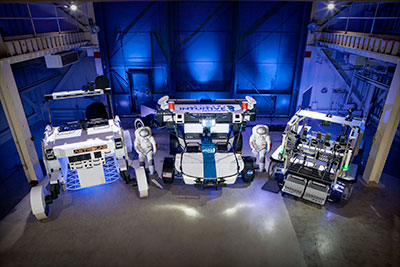 Above: From left to right: Astrolab's FLEX, Intuitive Machines' Moon RACER, and Lunar Outpost's Eagle lunar terrain vehicle at NASA's Johnson Space Center. (NASA/Bill Stafford) As part of an ongoing year-long feasibility study, each company delivered a static mockup of their vehicle to Johnson at the end of September, initiated rover testing in October and completed the first round of testing in December inside the Active Response Gravity Offload System (ARGOS) test facility. Lunar surface gravity is one-sixth of what we experience here on Earth, so to mimic this, ARGOS offers an analog environment that can offload pressurized suited subjects for various reduced gravity simulations. NASA's engineering teams conducted tests where suited NASA astronauts and engineers performed tasks, maneuvers, and emergency drills on each rover. With astronauts acting as the test subjects, these human-in-the-loop tests are invaluable as crewmembers provide critical feedback on each rover's design functionality, evaluate display interfaces and controls, and help identify potential safety concerns or design issues. This feedback is shared directly with each commercial provider, to incorporate changes based on lessons learned as they evolve their rover design. 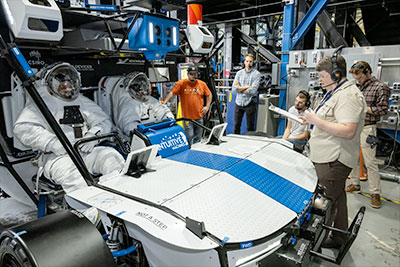 Above: NASA engineer Dave Coan (left) and NASA astronaut Jessica Watkins (right) sit inside from Intuitive Machines' Moon RACER lunar terrain vehicle evaluating the crew compartment during testing at NASA's Johnson Space Center. (NASA/James Blair) "We are excited to have mockups from all three LTV commercial providers here at Johnson Space Center," said Steve Munday, LTV project manager. "This is the first major test milestone within the Lunar Terrain Vehicle Services contract and to have actual rovers delivered only four months after these companies were awarded is remarkable." Testing consisted of NASA astronauts and engineers taking turns wearing both NASA's Exploration Extravehicular Mobility Unit planetary prototype spacesuit as well as Axiom Space's Axiom Extravehicular Mobility Unit lunar spacesuit. The test teams performed evaluations to understand the interactions between the crew, the spacesuits, and the LTV mockups. 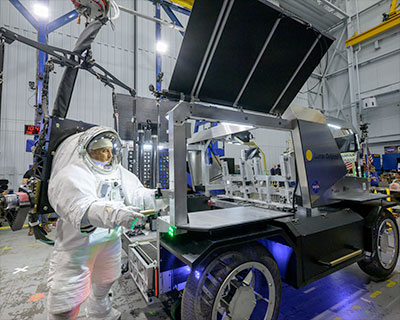 Above: NASA astronaut Joe Acaba raises the solar array panel on Lunar Outpost's Eagle lunar terrain vehicle during testing at NASA's Johnson Space Center. (NASA/Robert Markowitz) While wearing NASA's prototype spacesuit, crew members were suspended from ARGOS allowing teams to mimic theone-sixth gravitational field of the lunar surface. This allowed the crew members to conduct tasks on the outside of each rover, such as gathering or storing lunar geology tools, deploying science payloads, and handling cargo equipment, as if they are walking on the Moon. While wearing Axiom Space's pressurized spacesuit, teams evaluated the level of ease or difficulty in mobility crewmembers experienced when entering and exiting the rovers, the crew compartment and design, and the functionality of interacting with display interfaces and hand controls while wearing thick spacesuit gloves. 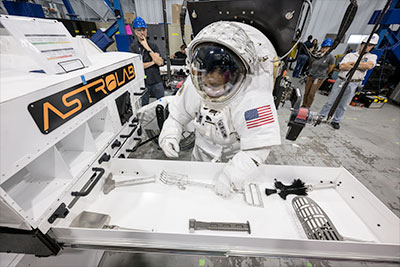 Above: NASA astronaut Jessica Watkins picks up a lunar geology tool from a stowage drawer on Astrolab's FLEX lunar terrain vehicle during testing at NASA's Johnson Space Center. (NASA/Robert Markowitz) As part of testing, teams also conducted emergency drills, where engineers simulated rescuing an incapacitated crew member. As part of NASA's requirements, each rover must have a design in place that enables an astronaut to single-handedly rescue their crewmates in the event of an emergency. Since NASA selected the companies, Intuitive Machines, Lunar Outpost, and Venturi Astrolab have been working to meet NASA's requirements through the preliminary design review. In 2025, the agency plans to issue a request for task order proposals to any eligible providers for a demonstration mission to continue developing the LTV, deliver it to the surface of the Moon, and validate its performance and safety ahead of Artemis V, when NASA intends to begin using the LTV for crewed operations. 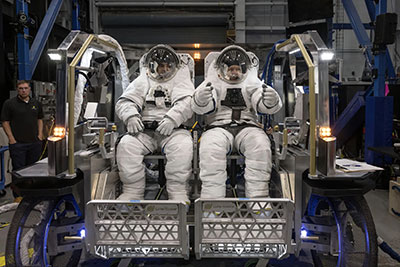 Above: NASA astronauts Raja Chari (left) and Randy Bresnik (right) sit inside Lunar Outpost's Eagle lunar terrain vehicle evaluating the seat configuration during testing at NASA's Johnson Space Center. (NASA/David DeHoyos) 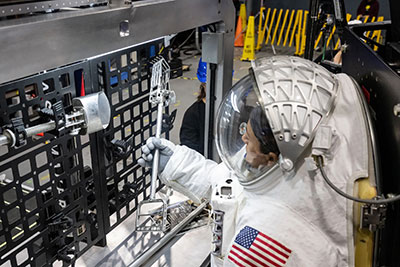 Above: NASA astronaut Jessica Meir grabs a lunar geology tool from a tool rack on Lunar Outpost's Eagle lunar terrain vehicle during testing at NASA's Johnson Space Center. (NASA/James Blair) 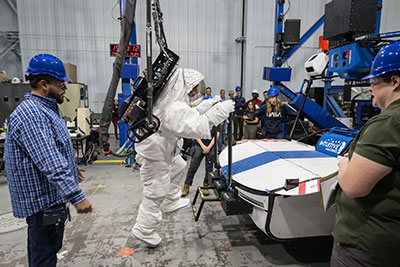 Above: NASA astronaut Joe Acaba prepares to climb on top of Intuitive Machines' Moon RACER lunar terrain vehicle to get a science payload during testing at NASA's Johnson Space Center. (NASA/Josh Valcarcel) 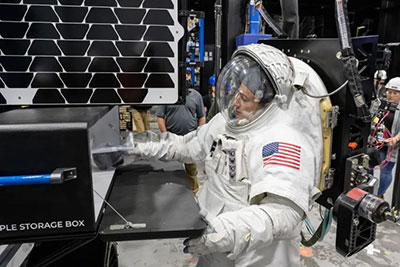 Above: NASA astronaut Jessica Meir puts a science sample inside a storage box on Intuitive Machines' Moon RACER lunar terrain vehicle during testing at NASA's Johnson Space Center. (NASA/James Blair) 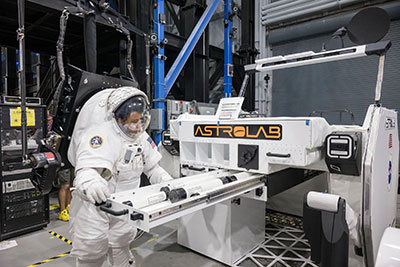 Above: NASA astronaut Jessica Watkins stores science payloads on Astrolab's FLEX lunar terrain vehicle during testing at NASA's Johnson Space Center. (NASA/Robert Markowitz) |
Robert Pearlman
Editor Posts: 54868
From: Houston, TX
Registered: Nov 1999
|
 posted 07-10-2025 07:19 PM
posted 07-10-2025 07:19 PM
   
NASA release NASA Selects Instruments for Artemis Lunar Terrain VehicleNASA has selected three instruments to travel to the Moon, with two planned for integration onto an LTV (Lunar Terrain Vehicle) and one for a future orbital opportunity. The LTV is part of NASA's efforts to explore the lunar surface as part of the Artemis campaign and is the first crew-driven vehicle to operate on the Moon in more than 50 years. Designed to hold up to two astronauts, as well as operate remotely without a crew, this surface vehicle will enable NASA to achieve more of its science and exploration goals over a wide swath of lunar terrain. "The Artemis Lunar Terrain Vehicle will transport humanity farther than ever before across the lunar frontier on an epic journey of scientific exploration and discovery," said Nicky Fox, associate administrator, Science Mission Directorate at NASA Headquarters in Washington. "By combining the best of human and robotic exploration, the science instruments selected for the LTV will make discoveries that inform us about Earth's nearest neighbor as well as benefit the health and safety of our astronauts and spacecraft on the Moon." The Artemis Infrared Reflectance and Emission Spectrometer (AIRES) will identify, quantify, and map lunar minerals and volatiles, which are materials that evaporate easily, like water, ammonia, or carbon dioxide. The instrument will capture spectral data overlaid on visible light images of both specific features of interest and broad panoramas to discover the distribution of minerals and volatiles across the Moon's south polar region. The AIRES instrument team is led by Phil Christensen from Arizona State University in Tempe. The Lunar Microwave Active-Passive Spectrometer (L-MAPS) will help define what is below the Moon's surface and search for possible locations of ice. Containing both a spectrometer and a ground-penetrating radar, the instrument suite will measure temperature, density, and subsurface structures to more than 131 feet (40 meters) below the surface. The L-MAPS instrument team is led by Matthew Siegler from the University of Hawaii at Manoa. When combined, the data from the two instruments will paint a picture of the components of the lunar surface and subsurface to support human exploration and will uncover clues to the history of rocky worlds in our solar system. The instruments also will help scientists characterize the Moon's resources, including what the Moon is made of, potential locations of ice, and how the Moon changes over time. In addition to the instruments selected for integration onto the LTV, NASA also selected the Ultra-Compact Imaging Spectrometer for the Moon (UCIS-Moon) for a future orbital flight opportunity. The instrument will provide regional context to the discoveries made from the LTV. From above, UCIS-Moon will map the Moon's geology and volatiles and measure how human activity affects those volatiles. The spectrometer also will help identify scientifically valuable areas for astronauts to collect lunar samples, while its wide-view images provide the overall context for where these samples will be collected. The UCIS-Moon instrument will provide the Moon's highest spatial resolution data of surface lunar water, mineral makeup, and thermophysical properties. The UCIS-Moon instrument team is led by Abigail Fraeman from NASA's Jet Propulsion Laboratory in Southern California. "Together, these three scientific instruments will make significant progress in answering key questions about what minerals and volatiles are present on and under the surface of the Moon," said Joel Kearns, deputy associate administrator for Exploration, Science Mission Directorate at NASA Headquarters. "With these instruments riding on the LTV and in orbit, we will be able to characterize the surface not only where astronauts explore, but also across the south polar region of the Moon, offering exciting opportunities for scientific discovery and exploration for years to come." Leading up to these instrument selections, NASA has worked with all three lunar terrain vehicle vendors - Intuitive Machines, Lunar Outpost, and Venturi Astrolab - to complete their preliminary design reviews. This review demonstrates that the initial design of each commercial lunar rover meets all of NASA's system requirements and shows that the correct design options have been selected, interfaces have been identified, and verification methods have been described. NASA will evaluate the task order proposals received from each LTV vendor and make a selection decision on the demonstration mission by the end of 2025. | |
Contact Us | The Source for Space History & Artifacts
Copyright 1999-2025 collectSPACE. All rights reserved.

Ultimate Bulletin Board 5.47a
|
|

|
 advertisement advertisement

|























